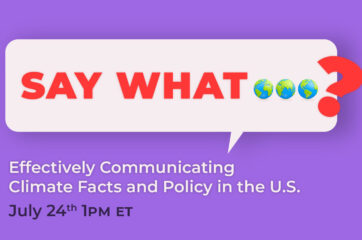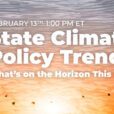In the absence of state and federal climate action, cities around the country have turned to local policies to ensure a cleaner, greener future for themselves. Unfortunately, many state legislatures have introduced and even enacted bills that prohibit such local climate policies, using a strategy known as preemptive legislation to target municipal efforts related to clean energy, electrification, and more. Understanding what this preemption language looks like, how it threatens both climate action and equity, and how to respond to it, is essential for state climate policy actors across sectors.
Joining us to discuss this in detail was Sara Zimmerman, Director of the Climate Equity Policy Center, who discussed what preemption looks like, how it threatens climate equity, and strategies to fight it, including building political power through coalitions across issue areas, enacting savings clauses, and litigating when it’s wise to do so. Logan Welde, Staff Attorney and Legislative Director of Clean Air Council, continued the conversation by exploring the impacts of Dillon vs. Home Rule on state preemption, Pennsylvania as a case study for preemptive natural gas and single-use plastic bills, and examples of litigation as a successful tool.
Sara Zimmerman, Climate Equity Policy Center
We’re in a fight for our lives right now — we’re fighting for communities, and for the future of life in this country and on this planet, and preemption is being used as a tool by our opposition. They’re using preemption to undermine democracy, to fight against climate policies that are threatening short term profits for corporations and to attack a range of different progressive policies that advance economic and racial justice. Preemption can be a tricky issue to rally people behind because it’s an obscure, confusing legal concept, and it can get buried really deeply within the legalistic language in a bill. However, preemption matters because it has the power to erase and undo local organizing and local victories. Understanding more about preemption helps us identify it, fight it, and keep winning on the issues.
What is Preemption?
So let’s start by talking about what preemption is. Preemption occurs when a state government or the federal government removes the authority of a lower level of government to pass laws on a topic. The concept of preemption arises because our different levels of government have a hierarchy of power. Generally, in any kind of conflict over law or authority, federal law is going to supersede state or local law, and state law is going to supersede local law. Although that’s the general idea, the details of exactly how preemption plays out are complex. Attempts at preemption often end up getting fought out in courts — it’s not always a done deal once a preemption bill is passed.
Preemption is currently being weaponized in a broad struggle over democracy between powerful corporate interests and people who care about our future. We’ve seen a steady increase in state laws restricting local authority over the past few decades, passed both by Republicans and by Democrats. But interestingly, one study that was looking at a couple of specific topics, including minimum wage and telecommunications regulation from 2001–2016, found that the majority of preemption laws over this period were passed when there was a Republican trifecta.
This rise in preemption is happening at the same time that we’re experiencing a number of other kinds of attacks on democracy — on voting rights and the ability of people to decide issues through direct democracy and ballot initiatives. These multi-pronged attacks make it hard to use democracy to correct some of the overreaches that are happening related to preemption. They’re also a reflection of the fact that our organizing has been very successful. It’s perceived as a threat so serious that our opposition is willing to attack democracy itself in order to fight back against it.
What does preemptive language look like?
Here’s an example of language that may appear in a bill:
“No ordinance or regulation of local government may prohibit or in any way attempt to regulate any matter related to [topic].”
Confusingly, a range of other phrases can also have the same effects. Language that focuses on providing the state or its agencies with exclusive or sole regulatory authority may be preemptive, as well as language that the state is occupying the field of regulation regarding a specific area. On the other hand, the opposite of preemptive language, known as a savings clause or enabling clause, specifically allows local governments to continue to regulate within an area despite the fact that the state government has acted in that area in some way.
Here’s an example of that language:
“Nothing in this act shall prevent any city or county from regulating on [topic], as long as such regulation is at least as stringent as that in this act.”
As we look at both of these clauses, neither of them actually contains the word “preemption”, which is frequently the case with preemptive legislation. That means that it can be hard to find preemptive clauses or savings clauses when they’re buried in a long bill. As a result, identifying preemption efforts can require being tapped into state politics in a way that can be very challenging for many groups, especially local groups that are really focused on the ground. This means that it’s important to have trusted partners who are working in state policy and are able to identify and alert other organizations when preemption arises, to ensure that there can be strong mobilization in response to this kind of threat.
Preemption and Climate Equity
Preemption bills can have a significant impact on climate equity. Climate equity policies are essential for righting wrongs and creating a just future, but we also need to focus on these from a political perspective. We need to pass policies that are inspiring and motivating for people in the majority of our country, working people and people of color. That will let us develop a momentum and political will that will allow us to keep building towards the kind of world that we want to see. We need to focus on policy change specifically, because that is an approach that lets us institutionalize our approaches. Local climate equity policies are really essential, because they let us experiment with different strategies. They are vehicles that allow us to create rapid change on the ground, close to where that change actually needs to happen.
The challenge is that while we’re working on all of that, conservative forces are both proactively and reactively attacking the tools that we’re using. Some of the types of laws that have been successfully attacked by state preemption include laws that are climate- and environment-focused, such as bans on natural gas in new buildings, pesticide use restrictions, limits on fracking, and bans on plastic bags or styrofoam. However, there are also attacks happening on laws that address economic and racial justice, LGBTQ rights, and public health.
There’s an underlying theme behind these different attacks on local authority and decision making. Legislators are using preemption as a tool to maintain profits and maintain conflict, to drive wedges between different groups that might otherwise work together to demand change. In all of these cases, preemption is being used to maintain racial and economic hierarchies, and to maximize power and control for the one percent and corporate interests.
Let’s zoom out and discuss how different levels of government are affected by preemption, and why broad preemption is really harmful for democracy. Different levels of government have different strengths and abilities. Local governments are key to implementing and carrying out core policy ideas on the ground, and they are great places to innovate. They allow policy experts and advocates to refine new approaches before passing state laws that may be more consistent, and demonstrate that a policy change won’t bring catastrophe. We often see blue cities in red states passing key policies, but these are particularly vulnerable to preemption efforts. The same issue can arise when we have dark blue cities in light blue or purple states passing ambitious or innovative policies.
Local policy is also much more responsive to local needs and demands than state policy can be. In some ways, this is the core of democracy — letting people control and govern their own lives. Preemption means that people need to affect state or federal policy in order to exert that kind of democratic control over their own lives. However, state and federal policy are much harder for community members to influence. It’s much easier to go to your city hall or have a relationship with your city council or mayor than it is to have a similar interaction with your state government, or certainly with the federal government. Additionally, state and federal policy are much more vulnerable to corporate lobbying and campaign finance pressures.
Finally, key policies for climate and equity happen at the local level. There are many policies that work best, in terms of their equitable approach and the impact that they have, when they’re tailored to local needs. That’s why we need to have local government authority.
It’s important to note that preemption is not inherently bad. There are reasons why it sometimes makes sense for the law to be the same everywhere. Take traffic law, for example, where it can be confusing and cause problems if there is a different law in every city. However, what we’re seeing right now is a broad movement to move decision making power away from the level that’s closest to people’s lives. State lawmakers generally are not using preemption to advance a thoughtful and balanced approach to a policy area. Instead, they’re using it to take power away from people in local communities to make decisions and achieve what they actually want.
Preemption Laws Superseding Natural Gas Bans
Natural gas bans are an example of all of these issues coming together. Natural gas bans are an incredible example of the power of local innovation and its ability to spread rapidly. The first natural gas ban, which banned fossil fuels in new construction, passed in Berkeley in 2019. Since then, more than 50 other cities and counties have followed suit. As the adoption of this policy spreads, the policy is changing and innovation continues. For example, Petaluma, California banned natural gas in new construction, but it also banned new gas stations, taking a broader approach that prohibited all new fossil fuel infrastructure. Ithaca, New York not only banned natural gas in new construction, but also introduced a plan and mandate to phase out natural gas by 2030. These different communities are taking the initial idea and trying out new things.
We’re also seeing some states begin to debate natural gas bans in new construction at the state level. States often look to what local governments did first to see what problems arose, and determine what to change before adopting a statewide policy. Rather than embracing this trend, which could have enormous, positive health impacts, the oil and gas industry has responded very aggressively. They have coordinated a national strategy coming from groups such as the American Gas Association, which has enabled them to preempt natural gas bans in 20, mostly red, states since 2020.
What does preparing for preemptive bills look like? We need to build political power and coalitions both within and across our movements. That allows us to be prepared and able to fight at different levels of government, and to have each other’s backs. These efforts build on each other — they allow us to achieve local victories, to amass the power to fight off state preemption efforts, and to achieve proactive goals at all levels of government. It’s also important to have strong, flexible, and knowledgeable coalitions.
How Can We Fight Preemptive Legislation?
Preemption arises in a variety of different ways, sometimes as state legislators halting a city’s efforts to enact some sort of progressive policy. But sometimes, preemption appears when a bill is being passed at the state level with some really progressive components. Preemption can be offered as a compromise in order to accomplish these other strong goals. As a result, preemption can be a wedge that divides a coalition, where some people are motivated to win short-term gains at the expense of long-term local democracy. Being prepared for that kind of issue ahead of time, and having honestly engaged and wrestled with it, means that coalitions are more likely to be able to resist those efforts should they arise. We should also focus on including specific savings language in state and federal bills to ensure that we’re proactively protecting local authority.
Once preemption has happened, we can fight it with litigation. We must determine if the given situation warrants this course of action, but fighting preemption through litigation can be a successful approach. We can also work to repeal preemption. An example of this was in 2019, when Colorado removed the state’s preemption of local regulation of oil and gas drilling. That move significantly shifted power to local communities. It hasn’t been perfect, but local communities have been able to put a variety of measures in place to increase safety for residents. Additionally, we can try to work around preemption. We have to keep being creative about how we do that, using incentives and thinking about how we maintain momentum.
Preemption is a serious threat to our climate and our justice focused policy efforts. We have to be vigilant about preemption and be aware of what it is and why it matters. This is a fight that we’ve been fighting, and will continue to fight. It’s an ongoing battle for democracy, for our rights to be ourselves, and for our ability to live and thrive in a healthy world. We’re going to lose some of these fights, and we’re going to win others. But we won’t stop fighting.
To learn more, explore Climate Equity Policy Center’s preemption resources, including their toolkit and factsheet, and sign up for their newsletter for notifications about upcoming resources.
Logan Welde, Clean Air Council
Laws Granting Power to Local Government
Let’s start with some background on municipalities, preemption, and powers. The Constitution doesn’t necessarily say anything about local governments, but it does reserve the powers that aren’t delegated to the states for local communities. Generally, there are two rules of governance guiding local governments: Dillon Rule and Home Rule.
Dillon rule is the more restrictive of the two, saying that local government only exercises (1) powers expressly granted by the state, (2) powers necessarily and fairly implied from the grant of power, and (3) powers crucial to the existence of local government. Basically, all local powers flow from the state’s power, and local governments only exist because they’re allowed to exist from the state. Dillon rule is very prominent throughout the country.
On the other hand, Home Rule allocates some autonomy to a local government, if the local government accepts certain conditions. Home Rule implies that each level of government has a separate realm of authority. Therefore, state power should not infringe on the authority of local government in certain areas. Home Rule gives more power than Dillon Rule, although it still is restrictive. The vast majority of states are under some form of Dillon rule, either a Dillon-Home Rule combination or just Dillon rule.
Pennsylvania as a Case Study for Preemption
Specific states are more susceptible to preemption than others, such as Florida, Tennessee, Arizona, and Pennsylvania. Focusing on Pennsylvania as an example, preemption proliferates for a few contextual reasons. Pennsylvania is a deeply red state with a few significant outliers in certain cities. It has the largest full-time state legislature, which is controlled by Republicans. Pennsylvania is a Home Rule state, so while it allows local governments to rule themselves, it does limit them. The legislature is still given the power to restrict Home Rule localities’ actions, except for Philadelphia due to its size.
Additionally, the American Legislative Exchange Council (ALEC) is strong in Pennsylvania, and you can’t talk about preemption without talking about ALEC. They are by far the largest and most well known organization writing this sort of legislation across states, and one of our State Representatives, Seth Grove, is on the board of ALEC. In Pennsylvania, ALEC has an outsized role because of the strong dominance of Republicans in both the House and the Senate and they are the source of many Pennsylvania bills.
There are many examples of climate preemption in Pennsylvania, the first of which is Act 13 of 2012. This required all municipalities to allow oil and gas drilling anywhere in any part of their municipality, and it preempted almost all local restrictions. This ushered in the boom of fracking in Pennsylvania, as there were local laws that prevented drilling through zoning laws, but Act 13 preempted that. It limited the ability of municipalities to consider the effects of oil and gas operations differently from other land uses, and it gave the Department of Environmental Protection near total authority over the operations for streams and wetlands.
In the case of Act 13, municipalities immediately fought back through Robinson Twp. v. Commonwealth, arguing that Act 13 violated certain provisions of the Pennsylvania Constitution that protected inherent rights, limited eminent domain, and preserved natural resources. The Pennsylvania Supreme Court took the case on appeal and the majority invalidated the land-use regulations, among other provisions of Act 13.
There are many upcoming challenges with preemption, as we’ve seen a surge of preemptive legislation during COVID, like Florida’s law allowing businesses to sue cities and counties if their revenues decline by 15 percent or more. In Pennsylvania, there’s going to be a ballot question on, effectively, gerrymandering the Supreme Court. There was another ballot measure introduced in May of 2021 that stripped the governor’s powers during COVID. When there’s a Democratic governor, we’re seeing a movement from preemption at the legislative level, to the ballot level.
So, what has worked? Litigation has been successful, as in the case of Act 13 and with single-use plastics. Early action to understand what’s likely to come is also important; organizations like the Local Solutions Support Center provide this exact sort of help. You can look at what’s happening in Florida and know that it’s going to come to your state at some point, so work with municipal leagues and local leaders in advance. We’ve also seen a lot of success in going after the dues of these large organizations like ALEC and the American Gas Association — all these groups are getting dues paid to them by your utility company. Lastly, join coalitions — if you’re in Pennsylvania, you can join our coalition against preemption.
Question: What are examples of state successes after preemptive legislation has been passed?
Sara: At the state level, there are two specific things you can do to deal with an existing preemption, and one is that you can pass a law that has a savings clause. This overrides any previous preemption by explicitly and expressly delegating authority to local municipalities to act. The second option is repealing the preemption effort itself, with dozens of examples of preemption being repealed, such as in Colorado. This can come up in hotly fought-out ways, but it also comes up in a shift of legislature power or a shift of understanding of what kinds of policies should be playing out. So it’s not a controversial approach. But there is more preemption passed than it is repealed, and so it’s certainly a challenge.
Logan: Yeah, it’s pretty hard to change it once it’s passed and becomes law. So the key is to know what’s coming, and fight it immediately. The gas preemption bill, we knew it was coming to Pennsylvania, it had not been introduced yet. So we got municipal leagues, local governments who had climate policies, and things like that. We got them all on board, they testified against it, and that swayed some people. If you have a Democratic governor who can veto things, that does make it easier, but you need all those backstops to happen. The litigation has also been successful. In one lawsuit, Pa. Rest. & Lodging Ass’n v. City of Pittsburgh, the Supreme Court is being favorable to hearing the public health argument and saying, “Hey, we’ve got to balance Home Rule with public health concerns”. So there are other legal arguments you could make. In Pennsylvania, each bill has to have one single subject, and it’s not legal otherwise. That was one of our claims when litigating the plastic preemption. There are also five or six states with environmental rights amendments. Void for vagueness is another one, when they make the wording of the bill so vague, you could attack that this law can’t be allowed, because it’s just too hard to understand what it means. Having a very creative legal solution to some of these lawsuits once they become laws is important, but it is hard.
Conclusion
State preemption of local climate action is rampant in legislatures across the country, with bills related to natural gas, single-use plastics, and more. However, Sara Zimmerman and Logan Welde reminded us that there are ways to protect your state against preemptive legislation before it happens, and to fight preemptive bills once they’ve passed. Key to both is strong coalitions across sectors and localities alongside creative legal strategy. Whether your state has already introduced or passed preemptive legislation or not, it is essential that climate policy actors educate themselves and mobilize alongside other stakeholders to create the immense power needed to fight this attack on our communities, our futures, and our very democracy.








